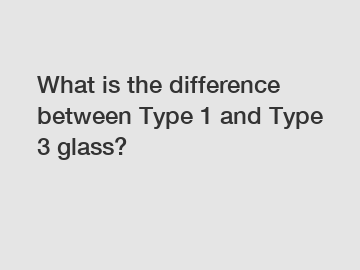What is the difference between Type 1 and Type 3 glass?
What is the difference between Type 1 and Type 3 glass?
Glass is an essential material that is used in various industries, ranging from construction to packaging. When it comes to glass classification, two commonly referred types are Type 1 and Type 3 glass. Understanding the differences between these types can help in choosing the right glass for specific applications.
Type 1 glass, also known as borosilicate glass, is composed of silica and boron trioxide. It is highly resistant to thermal shock, which means it can withstand sudden temperature changes without cracking. This makes Type 1 glass ideal for applications that involve extreme temperature variations, such as laboratory glassware and cookware.

The origins of Type 1 glass can be traced back to German glassmaker Otto Schott, who developed borosilicate glass in the late 19th century. Its unique composition, with the addition of boron trioxide, gives it superior thermal resistance compared to other types of glass. This property was a result of Schott's experimentation and desire to create a glass that could withstand the rigors of scientific experimentation.
The classification of Type 1 glass as borosilicate glass has significant implications in the scientific community. Its resistance to thermal shock allows scientists to conduct experiments at varying temperatures without the fear of glassware breaking. This has revolutionized scientific research by enabling precise control over experimental conditions.
In contrast, Type 3 glass, also known as soda-lime glass, is composed of silica, soda, and lime. It is the most common type of glass used in everyday applications, such as windows, bottles, and jars. Soda-lime glass is less resistant to thermal shock compared to Type 1 glass, making it unsuitable for applications that involve extreme temperature changes.
The composition of soda-lime glass, with the addition of soda and lime, results in a more cost-effective and easily producible glass. Its origins can be traced back to ancient Persia and Egypt, where glassmaking techniques using soda and lime were developed. The ability to mass-produce soda-lime glass has made it the go-to choice for many industries, thanks to its affordability and versatility.
In summary, the main difference between Type 1 and Type 3 glass lies in their composition and thermal properties. Type 1 glass, or borosilicate glass, is highly resistant to thermal shock and widely used in scientific and industrial applications that require precise control over temperature changes. On the other hand, Type 3 glass, or soda-lime glass, is less resistant to thermal shock and commonly used in everyday applications due to its cost-effectiveness and versatility. Understanding these differences allows for informed decisions when selecting the appropriate glass for specific purposes.
For more what is tubular glass vials manufacturing process, oral liquid vials manufacturer, amber glass ampouleinformation, please contact us. We will provide professional answers.


